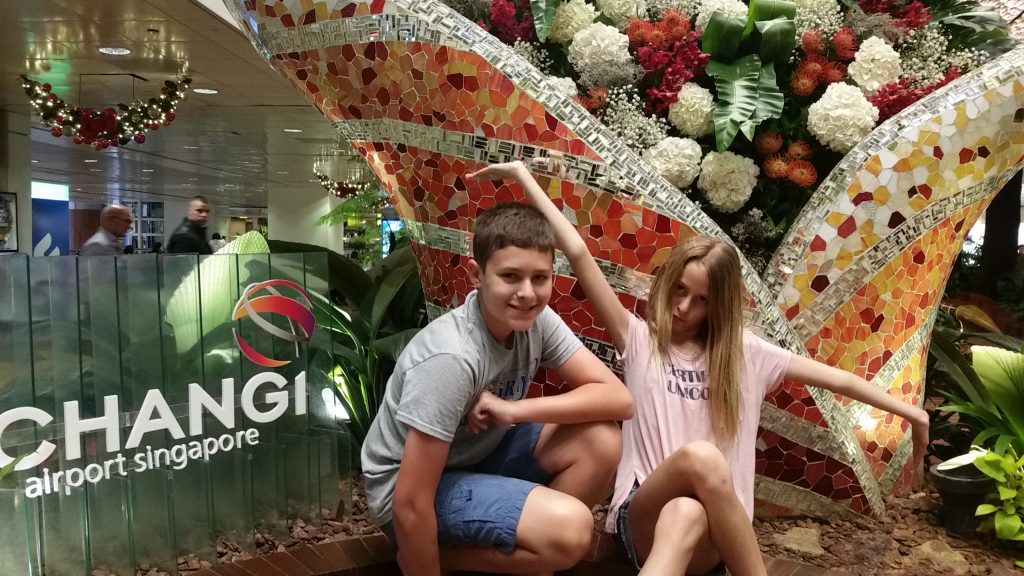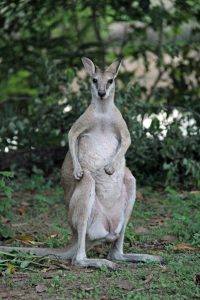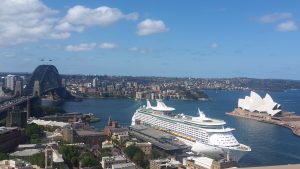
by Jason Bowles | Dec 1, 2017 | Indonesia, Jason
Never planned to be here but at this point, we are just winging it. Kids are having fun–Changi Airport is like an amusement park. They are already asking when we can return. Video games, movie theaters, a butterfly garden (plus others dedicated to orchids, sunflowers, fairies). . . Our 3-hour layover was too short for them.
I’ve never been, but I suspect Jakarta may not be quite as nice. We’ll find out soon enough.

Changi Airport, Singapore


by Jason Bowles | Nov 29, 2017 | Australia, Jason
Darwin, Northern Territory—the Top End of Australia. Totally different than the other places we have been so far. Hot, humid, tropical. We came for the parks and the animals. First, Kakadu: a huge park, more than a third of it wetlands. Famous for its birds and crocodiles, and we saw plenty of both. Cruising the South Alligator river (like Heron Island, named in error as there are no alligators in Australia) and the surrounding billabongs, we saw numerous large salt water crocs (they grow up to 5 meters up here!) as well as spectacular bird life.

Kakadu Crocodile
Currently we are in Adelaide River, near Litchfield National Park. Looking for swimming holes today! We are surrounded by wallabies here.

Wallaby in our front yard.
In other news, Gunung Agung is erupting on Bali, the airport has been closed for days and will probably remain so. As we were scheduled to fly to Bali tomorrow, this presents a problem. With tens of thousands of people stranded on Bali and everyone else trying to shuffle flights, it has actually been a very big problem. Fortunately, here in Adelaide River there is internet access–3 kilometers away at the Post Office. After much ado, we have a new plan. Well, part of a plan. We are going to fly to Jakarta on Friday (via Singapore). That is the plan so far (barely even a concept!). From Jakarta we are hoping to fly to Makassar (on Sulawesi, Indonesia). From Makassar, I have heard it is possible to fly to a small place further afield on Sulawesi (Wangi-wangi island) which is only 4 hours by boat from Wakatobi, which is where we would really like to be. Wish us luck!

by Jason Bowles | Nov 26, 2017 | Australia, Jason
Iconic. While the word is probably overused, there is no doubt that it applies to Uluru. The only thing that probably surpasses it as the most recognizable landmark in Australia is Sydney’s Opera House. The Opera House is spectacular–perfectly situated on Bennelong point with the Harbor Bridge just beyond–there is no doubt. But if the Opera House is the face of Australia, there is no doubt that Uluru is the heart, figuratively and literally. It is found in the heart of Australia, an area known as the Red Centre. A national park encompasses both Uluru and a neighboring rock formation, Kata Tjuta. Uluru is a massive sandstone monolith that rises 1,142 feet from the desert plain surrounding it. It seems to be the only thing occupying an otherwise featureless plain. Even Kata Tjuta is more than 20 miles away.
From the air and at a distance Uluru impresses with is size and isolation, a monstrous rock protruding with nothing else in sight. To say it dominates the landscape doesn’t do it justice. It IS the landscape. Instantly recognizable. . . Iconic. As you get closer though, Uluru comes alive. We were lucky to arrive after a very wet year and the desert was greener than I would have imagined the Australian Outback to be. Closer yet, pools of water could be found with black-streaking algae cascading down from the heights, like shadows of the waterfalls that created them. Looking even closer, in the shady caves at the base of the monolith, are pictographs telling the stories of the Aboriginal people who have lived here for tens of thousands of years. The traditional owners of Uluru and the surrounding lands, the Anangu, still live here and still use these caves for the ceremonies like their ancestors have for countless generations. Areas of particular significance to the Anangu are not accessible to tourists, and many other areas can be approached but not photographed out of respect for their beliefs and traditions. It wasn’t always like this, but in 1985 the Australian government gave the land back to the Anangu, who in turn leased it back to the government with the stipulation that the park is jointly managed by the Anangu and the Director of National Parks.
I wasn’t sure what to expect, coming to Uluru from southern Utah. Having spent so much time among our wealth of spectacular red rock landscapes, I did not know if it would be slightly less impressive with subconscious comparisons of our rocks to theirs. Not to worry, Uluru exceeded my expectations. From a distance, it is just as spectacular, just as imposing as the classic photos make it out to be. Images fail to capture the evolution of changing colors throughout the day or the lush pockets of life hidden in the various cracks and folds of the rock, or the Anangu culture that surrounds Uluru. Uluru truly is iconic; instantly recognizable, but so much more than a large lump on a desert plain. You really need to appreciate the different perspectives offered as you circle the monument on the base walk, and learn more about the cultural significance of Uluru to the Anangu people from a park ranger on the Mala walk to appreciate what makes Uluru the heart of Australia.

Family photo at sunrise
by Jason Bowles | Nov 18, 2017 | Australia, Jason
It’s like staying in the middle of a Planet Earth photo shoot. Not the sterile, edited version that finally receives the Attenborough voice-over though. It feels more like the raw, uncut footage waiting for someone to put some order to it. There are so many competing stories at work here. At this time of year, hundreds of thousands of nesting birds await the turtle hatch. Not quietly, though. This many birds make quite a racket. And they are not shy. Birds constantly dart from here to there, just overhead. Very disconcerting when you consider the white-washing of the path you are following and the trees that line it. White-capped noddies are everywhere, making their nests in the pisonia trees that fill the interior of the island. Egrets wait near our dry rinse basin for the fresh water they know will fill it eventually. The general cacophony becomes an almost relaxing soundtrack, a constant reminder that Heron is not like any other island resort we have visited. Here, the birds are not a nuisance but an important part of the appeal of the island. Most of the birds, anyway. The seagulls can be quite annoying. Early in the morning, gulls will march up on to our deck, stand at our closed door and yell at us. They are probably used to food offerings, just to make them go away.
Wildlife is what Heron Island is all about. It sits on the southern end of the Great Barrier right at the Tropic of Capricorn, far enough south to avoid the coral bleaching that has been plaguing most of the reef. Sharks and rays are common, but it is the turtles that have made Heron famous. Thousands of loggerhead and green sea turtles return here every year to lay their eggs. We were fortunate to have loggerhead turtles at least three feet in diameter digging nests right in front of our beach house. In a couple of months, the eggs will hatch, and countless baby turtles will run the formidable gauntlet posed by the hungry birds anxiously awaiting the hatch. With so many natural spectacles on offer, it is not surprising that the island is also home to a permanent research center affiliated with the University of Queensland.

by Jason Bowles | Nov 13, 2017 | Australia, Jason

Room with a view
Fifteen hours, non-stop from Los Angeles—that’s a long flight. Not our longest, but close to it. Sydney is different, though. Usually the further you get from home, things change. The longer the flight, the more exotic the destination. Not Sydney. The most remarkable thing about the fifteen-hour flight to Sydney is that, on arriving, you feel like you never left home. Not that it is like any one place, it just doesn’t feel “foreign”. It’s not the language—English is the official language elsewhere, but when in London or Singapore there is no question that you have left the United States far behind.
Arrived in Sydney this morning, checked into the Quay West Suites. Easy to settle into vacation mode when you have this iconic view from your room!









